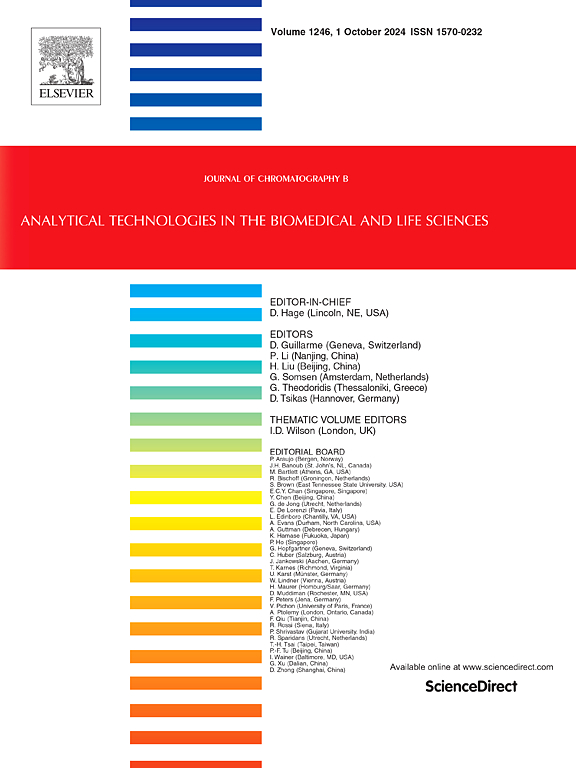溶解蛋白E和溶解蛋白D生物合成的跨物种比较:暴露于α -亚麻酸、二十碳五烯酸和二十二碳六烯酸的鱼和人细胞的液相色谱质谱定量分析
IF 2.8
3区 医学
Q2 BIOCHEMICAL RESEARCH METHODS
引用次数: 0
摘要
溶解蛋白是在生物体中溶解炎症过程中必不可少的脂质介质。研究表明,鱼类和人类细胞共享由二十碳五烯酸(EPA)和二十二碳六烯酸(DHA)分别产生分解蛋白E (RvE)和D (RvD)的酶促途径。然而,膳食α-亚麻酸(ALA)是分解素的间接前体,因为它是EPA和DHA的代谢前体,因此对其产生分解素的跨物种比较仍然有限。为了解决这个问题,我们验证了一种液相色谱质谱法,用于定量暴露于ALA、EPA和DHA的鲑鱼头部肾细胞和人外周血单个核细胞释放到培养基中的RvE和RvD。使用鱼和人细胞培养基对测定性能进行了评估,显示出符合国际准则的可接受结果。关键性能参数包括选择性、范围(0.5 ~ 50 ng/mL)、线性度(R2 = 0.98 ~ 0.99)、检出限(~ 0.02 ~ 0.09 ng/mL)、定量限(~ 0.08 ~ 0.3 ng/mL)和准确度(~ 97 ~ 109%)。经过验证的方法实现了可靠的跨物种比较,并揭示了DHA→RvD转化是鱼类和人类细胞中的主要途径。相比之下,EPA→RvE和ALA-间接途径(ALA→EPA/DHA→RvE/RvD)在两种物种中贡献最小。值得注意的是,该研究还指出,尚未报道DHA→EPA→RvE参与的逆转录途径。本文章由计算机程序翻译,如有差异,请以英文原文为准。
Cross-species comparison of resolvin E and resolvin D biosynthesis: Quantification by liquid chromatography mass spectrometry in fish and human cells exposed to alpha-linolenic acid, eicosapentaenoic acid, and docosahexaenoic acid
Resolvins are lipid mediators essential for resolving inflammatory processes in living organisms. Studies have shown that fish and human cells share enzymatic pathways to produce resolvins E (RvE) and D (RvD) from eicosapentaenoic acid (EPA) and docosahexaenoic acid (DHA), respectively. However, cross-species comparisons of resolvin production from dietary α-linolenic acid (ALA), an indirect precursor to resolvins as it is the metabolic precursor to EPA and DHA, remain limited. To address this, a liquid chromatography mass spectrometry method was validated for quantifying RvE and RvD released into culture media by salmon head kidney cells and human peripheral blood mononuclear cells exposed to ALA, EPA, and DHA. The assay performance was evaluated using both fish and human cell culture media, demonstrating acceptable results according to international guidelines. Key performance parameters included selectivity, range (0.5–50 ng/mL), linearity (R2 = 0.98–0.99), limits of detection (∼0.02–0.09 ng/mL), limits of quantification (∼0.08–0.3 ng/mL), and accuracy (∼97–109 %). The validated method enabled a reliable cross-species comparison and revealed that the DHA → RvD conversion is the predominant pathway in both fish and human cells. In contrast, the EPA → RvE and ALA-indirect pathways (ALA→EPA/DHA → RvE/RvD) contributed minimally in both species. Notably, the study also indicated, the involvement of a retroconversion pathway: DHA → EPA → RvE not being reported yet.
求助全文
通过发布文献求助,成功后即可免费获取论文全文。
去求助
来源期刊

Journal of Chromatography B
医学-分析化学
CiteScore
5.60
自引率
3.30%
发文量
306
审稿时长
44 days
期刊介绍:
The Journal of Chromatography B publishes papers on developments in separation science relevant to biology and biomedical research including both fundamental advances and applications. Analytical techniques which may be considered include the various facets of chromatography, electrophoresis and related methods, affinity and immunoaffinity-based methodologies, hyphenated and other multi-dimensional techniques, and microanalytical approaches. The journal also considers articles reporting developments in sample preparation, detection techniques including mass spectrometry, and data handling and analysis.
Developments related to preparative separations for the isolation and purification of components of biological systems may be published, including chromatographic and electrophoretic methods, affinity separations, field flow fractionation and other preparative approaches.
Applications to the analysis of biological systems and samples will be considered when the analytical science contains a significant element of novelty, e.g. a new approach to the separation of a compound, novel combination of analytical techniques, or significantly improved analytical performance.
 求助内容:
求助内容: 应助结果提醒方式:
应助结果提醒方式:


